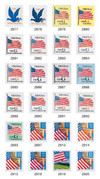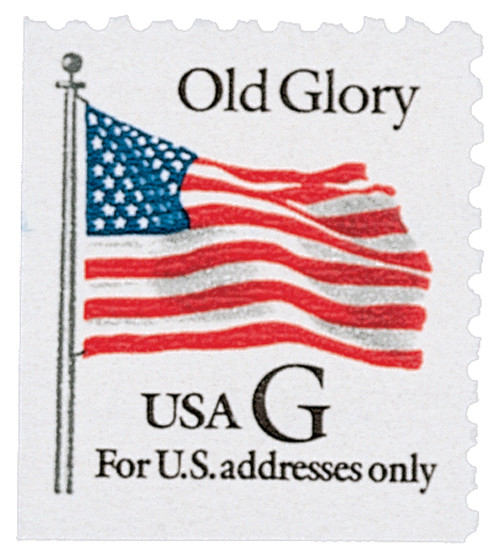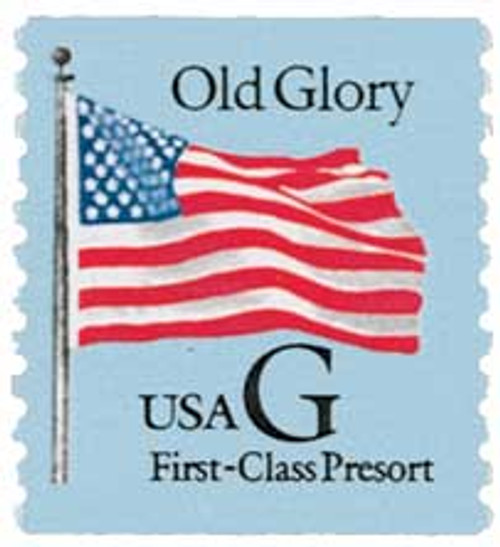
# 2877//2920 - 1995 Regular Issues, set of 24 stamps
U.S. #2877//2920
1994-95 Regular Issue Stamp Set
- 17 stamps that were issued for the new G-rate change
Stamp Category: Definitive
Printed by: Bureau of Engraving and Printing (BEP), Stamp Venturers, KCS Industries, Avery Dennison, and American Bank Note Company (ABNC)
Printing Method: Gravure and Offset
Format: Sheet, booklet, and coil.
Perforations: Varied
Why the stamps were issued:
The USPS issued this G series general-use stamp for the new first-class rate that would take place in 1995. The Flag Over Porch and Flag Over Field were issued for the new 32¢ rate.
About the stamp designs:
Old Glory was designed by Ronald Sharpe who was the first African-American Banknote Designer at the Bureau of Engraving and Printing.
The dove was picked by Richard Sheaff, of Sheaff Design Inc., found the flying dove from archives of past concepts. The designer was Robert Brangwynne.
Flag Over Porch was designed by artist Dave LaFleur from Derby, Kansas. Richard Sheaff gave him the directions to design a stamp with a flag hanging over a porch. Sheaff specified the “gingerbread trim” and to make it look like “grandma’s porch.” From those directions and a few concepts and corrections came the Flag Over Porch set with nearly as many printers and formats as the G Series.
Special design details:
The “G” on each first-class rate stamp changes color depending on the printer. For instance, a red “G” means it was printed by Stamp Venturers, a blue “G” mean it was printed by American Banknote Corporation and a black “G” is Bureau of Engraving and Printing. The one exception is Avery Dennison who did black G’s as well, but since the stamps are the only self-adhesive, they are easy to tell apart from the BEP stamps.
The three printers (BEP, Avery Dennison, and Stamp Venturers) were given free rein to reproduce the artwork in a way them saw the best outcome. All three chose the gravure printing method. However, they each chose different colors, cropping, and type, so the stamps themselves vary noticeably.
About the G-rate Series:
The USPS issued G-rate stamps to aid in the transition of a new postal rate. All, except two, G-rate stamps picture the US Flag with “Old Glory” in text above it, the other two are blue doves. They released eighteen different versions of G-rate stamps. These came in six different formats, in five varied rates, from five different printers! These include six different sheet stamps, six coils, four booklets, and two self-adhesives. This made the G-rate stamps printed by more printers and in more formats that any previous rate change stamp.
History the G- rate stamps represent:
The US Postal Service started making rate change stamps, or “contingency” stamps as they were known, in 1978 with the A-rate which was fifteen cents. They wanted to make sure they had stamps to fulfill any rate change, gap in prices, or any combination. In early 1981 the B-rate stamps were issued to make up eighteen cents. At the end of 1981 the C-rate for twenty cents was issued. A few years went by before the D-rate came along in 1985. With the E-rate collectors saw a shift from an eagle with the color stamp to the image reflecting the letter, E having an Earth on the stamp in 1988. The F make-up-rate was only four cents and depicted a tulip on the stamp. G-rate was in 1995 and H followed in 1999. Collectors thought they were going to keep going following the rest of the alphabet, but H was where it ended. Many joked that the US Postal Service didn’t want to issue an I-rate stamp, but the reasons behind the end was never clear.
U.S. #2877//2920
1994-95 Regular Issue Stamp Set
- 17 stamps that were issued for the new G-rate change
Stamp Category: Definitive
Printed by: Bureau of Engraving and Printing (BEP), Stamp Venturers, KCS Industries, Avery Dennison, and American Bank Note Company (ABNC)
Printing Method: Gravure and Offset
Format: Sheet, booklet, and coil.
Perforations: Varied
Why the stamps were issued:
The USPS issued this G series general-use stamp for the new first-class rate that would take place in 1995. The Flag Over Porch and Flag Over Field were issued for the new 32¢ rate.
About the stamp designs:
Old Glory was designed by Ronald Sharpe who was the first African-American Banknote Designer at the Bureau of Engraving and Printing.
The dove was picked by Richard Sheaff, of Sheaff Design Inc., found the flying dove from archives of past concepts. The designer was Robert Brangwynne.
Flag Over Porch was designed by artist Dave LaFleur from Derby, Kansas. Richard Sheaff gave him the directions to design a stamp with a flag hanging over a porch. Sheaff specified the “gingerbread trim” and to make it look like “grandma’s porch.” From those directions and a few concepts and corrections came the Flag Over Porch set with nearly as many printers and formats as the G Series.
Special design details:
The “G” on each first-class rate stamp changes color depending on the printer. For instance, a red “G” means it was printed by Stamp Venturers, a blue “G” mean it was printed by American Banknote Corporation and a black “G” is Bureau of Engraving and Printing. The one exception is Avery Dennison who did black G’s as well, but since the stamps are the only self-adhesive, they are easy to tell apart from the BEP stamps.
The three printers (BEP, Avery Dennison, and Stamp Venturers) were given free rein to reproduce the artwork in a way them saw the best outcome. All three chose the gravure printing method. However, they each chose different colors, cropping, and type, so the stamps themselves vary noticeably.
About the G-rate Series:
The USPS issued G-rate stamps to aid in the transition of a new postal rate. All, except two, G-rate stamps picture the US Flag with “Old Glory” in text above it, the other two are blue doves. They released eighteen different versions of G-rate stamps. These came in six different formats, in five varied rates, from five different printers! These include six different sheet stamps, six coils, four booklets, and two self-adhesives. This made the G-rate stamps printed by more printers and in more formats that any previous rate change stamp.
History the G- rate stamps represent:
The US Postal Service started making rate change stamps, or “contingency” stamps as they were known, in 1978 with the A-rate which was fifteen cents. They wanted to make sure they had stamps to fulfill any rate change, gap in prices, or any combination. In early 1981 the B-rate stamps were issued to make up eighteen cents. At the end of 1981 the C-rate for twenty cents was issued. A few years went by before the D-rate came along in 1985. With the E-rate collectors saw a shift from an eagle with the color stamp to the image reflecting the letter, E having an Earth on the stamp in 1988. The F make-up-rate was only four cents and depicted a tulip on the stamp. G-rate was in 1995 and H followed in 1999. Collectors thought they were going to keep going following the rest of the alphabet, but H was where it ended. Many joked that the US Postal Service didn’t want to issue an I-rate stamp, but the reasons behind the end was never clear.















